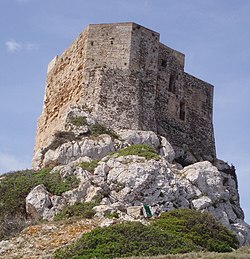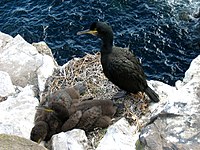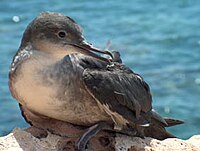Maritime-terrestrial National Park of the Cabrera Archipelago
The Maritime-Terrestrial National Park of the Cabrera Archipelago is a Spanish protected natural area made up of a group of islets belonging to the Balearic archipelago that was declared a national maritime-terrestrial park on April 29, 1991 by Law 14/1991 and whose size increased eight times in 2019.
It has a great natural value, since, due to its isolation throughout history, it has survived to this day practically unaltered: the coastal landscape of Cabrera can be considered one of the best preserved on the Spanish coasts, and one of the best in the entire Mediterranean. It is also home to important colonies of seabirds and endemic species. Due to its biotic richness and the abundance and variety of birds, it has also been declared a Special Protection Area for Birds (ZEPA) and a Special Conservation Area, so it is integrated into the Natura 2000 Network. of Specially Protected Area of Importance for the Mediterranean (ZEPIM) of the protocol of marine protected areas of the Barcelona Convention for the protection of the Mediterranean Sea.
Administratively, this archipelago belongs to the municipality of Palma de Mallorca. With 120,505 visitors annually (2015), the Cabrera Archipelago is the fourteenth national park in Spain in number of visitors.
History
The island of Cabrera and the larger islets have been visited by the main Mediterranean civilizations: Phoenicians, Carthaginians, Byzantines and Romans.
During the 13th and 14th centuries, the island of Cabrera and its natural port were used by Barbary pirates as a base from which to attack the Majorcan coasts.
For this reason, as early as the XIV century, a castle was built at the entrance to the port. This castle prevented the port from being used as a pirate base and allowed greater surveillance of the waters near Mallorca.
In 1808, the Spanish War of Independence broke out. The French soldiers who were taken prisoner in the Battle of Bailén ended up imprisoned on the island of Cabrera. In reality there was no building that could be called a prison: captivity was the very isolation of the island. This captivity ended in 1814, when peace was signed. Due to the scarcity of resources on the island and the lack of supplies by the authorities of the Junta de Defensa de Mallorca, no more than half were still alive at the end of the war; and in memory of these prisoners, a monolith was erected on the island.
At the end of the XIX century, the island of Cabrera became private property. The owners, the Feliu family, try to grow vines on the island. For this they built a winery, which is currently used as a museum.
In 1916, the archipelago was expropriated by defense interests. A small garrison is established on the island of Cabrera. The island would be used until its conversion into a national park as a target practice area. This military presence protected the natural environment by preventing the archipelago from being the object of property speculation.
In March 1991, Cabrera was declared a Maritime and Terrestrial National Park. On February 1, 2019, its limits were extended, incorporating adjacent marine spaces in an area of 80,779.05 hectares, with which its new extension is 90,800.52 hectares.
Geography
Located 10 km from Cape Las Salinas (municipality of Santañí, in the south of the island of Mallorca), the Cabrera archipelago is actually a southern outcrop of the Sierras de Levante (Serres de Llevant).
Cabrera has a semi-arid climate, mild during winters and hot in summers; with an annual average of 18 °C. The archipelago is subjected to the stress of wind and salt. The park has an area of 90,800.52 ha, of which 89,482.52 are maritime and 1,318 are land. The maximum height is 172 m s. no. m., and the minimum depth exceeds 2000 m (before the 2019 expansion, it was 118 m).
Islands and islets
It is made up of 19 islands and islets. The largest in area is Cabrera, followed by Conejera. The other larger islands are Ses Rates, Els Estels, L'Imperial, Ses Bledes, Es Fonoll, Na Redona, L'Esponja, Na Plana, Na Pobra, S'Illot Pla, S'Illot and Na Foradada.
Order of islands and islets
The islands and islets, in order from north to south and from west to east, are:
- Na Foradada
- S'illot de na Foradada
- S'illot Pla
- Na Pobra
- Na Plana
- L'Esponja
- Counsellor (Conillera or illa dels Conills)
- Na Redona
- Cabrera
- S'illa des Fonoi
- S'illa de ses Bledes
- S'illa de ses Rates
- S'Estell Xapat
- S'Estell de s'Esclata-Sang
- L'Imperial
- S'Estell des Coll
- S'Estell de Fora
Flora and fauna
Flora
Regarding the marine flora, it must be remembered that around 98% of the surface of the Cabrera National Park is sea. Under the waters that surround this set of islands, a multitude of plant species and algae have their habitat that, thanks to the clarity that the waters reach, are easily located. It is possible to observe more than 160 species, among which the algae stand out for their number. The most impressive are the Posidonia oceanica meadows: similar to algae, Posidonia is actually a higher plant that has roots and flowers, considered one of the main sources of life in the Mediterranean and unfortunately in serious regression along the entire coast..
The park is based on limestone, marl and dolomites of Tertiary origin, and has a Mediterranean climate. In the terrestrial environment, the archipelago presents a typical Mediterranean vegetation, with a very widespread community of maquis with wild olive trees and xeric scrub, with some Aleppo pine groves. However, Cabrera shows some peculiarities: next to the wild olive, the olivillo, the buckthorn, the spurge, there are typical species of the holm oak, such as the endemic buckthorn Rhamnus ludovici-salvatoris and, at higher levels, the Balearic boxwood (Buxus balearica).
Another characteristic is the wide extension of the juniper groves, precisely where the soil is scarcer.
The subspecies to which these junipers belong is Juniperus phoenicea turbinata (Guss.) Nyman.
The archipelago has 22 endemic Balearic species, such as the Balearic astragalus (Astragalus balearicus) and the Balearic St. John's wort (Hypericum balearicum), and only one endemic subspecies of Cabrera: Rubia angustifolia caespitosa.
Wildlife
The Cabrera archipelago, together with the waters and sea beds that surround it, constitutes one of the best-preserved natural spaces in the Mediterranean, teeming with life, both marine and terrestrial. Its waters are surprising for their exceptional transparency and visibility, for their underwater caves, in which uncataloged species continue to appear, such as several endemic crustaceans discovered in the waters of a cave. The fact that the archipelago is far from urban centers and that it does not receive any contribution from continental waters minimizes the contamination of its waters, with which its biotopes appear extremely preserved. It is precisely the great biodiversity of these waters that has allowed the Cabrera Archipelago to be declared a national park
From the faunal point of view, the most important aspect of Cabrera's biotic richness, among many other things, is the abundance and variety of birds that live on the islands or pass through them, and that increase during the migration season, since thousands of birds use the archipelago as a resting area (up to 130 different species have been catalogued). This has made possible its declaration as ZEPA (Special Protection Area for Birds).
Amphibians are largely absent from the archipelago, mainly due to the lack of freshwater accumulations, a rather scarce commodity on the islands.
Marine fauna
The marine fauna is made up of more than 500 species, with 113 species of bryozoans, 22 of mollusks, 25 of crustaceans, 87 of sponges and 214 different species of fish, which makes the park the area with the greatest biodiversity fish throughout the Mediterranean. Salpas, sea bream, sea bass, cows, chopas and dentex abound. It is also easy to find sea urchins and cuttlefish. Groupers, scorpions, octopus, moray eels and conger eels inhabit the rocky bottoms, sharing space with the loggerhead turtle (Caretta caretta), the leatherback turtle (Dermochelys coriacea) and dolphins. However, the monk seal (Monachus monachus) no longer lives in the archipelago, and only a few wandering specimens can be seen.
The Mediterranean monk seal was once found along all Mediterranean coasts, including the Black Sea, and southward along the Atlantic coast and on the islands of north-west Africa.
Currently, due to the threats it has suffered and continues to suffer, its distribution has changed and its populations are fragmented into three areas. The largest populations are located in the eastern Mediterranean, especially on the islands of the Ionian Sea and the Aegean Sea, as well as on the coasts of Turkey, Albania, Croatia and Greece; in the western Mediterranean, in Algeria and Morocco and, in the North Atlantic in Cabo Blanco between Mauritania and the western Sahara and, in Madeira.
Its habitat includes both pelagic zones, small islands and coastal zones, although it is always in areas protected from access by its terrestrial predators. It is restricted to areas where there are caves with entrances from the sea and on small beaches protected by cliffs or by high tide. In the caves and especially in those that have beaches inside is where they reproduce.
Land reptiles
Among the reptiles, the populations of the Balearic lizard (Podarcis lilfordi), called sargantana in Mallorca, an endemic island species, stand out in particular. Only in the Cabrera Archipelago there are eleven subspecies that are distinguished by small variations in shape and color. They are rather modest in size, 15 centimeters from head to tail, blue and green, almost black. 80% of the population of this endemic reptile of the Balearic Islands is found in the Cabrera Archipelago and almost every island has its own subspecies; these forms have evolved differently due to the genetic isolation to which they have been subjected for 6000 years. The list of reptiles is completed with the abundant common gecko, called in Mallorca dragó, and the scarce pink gecko, called in Majorca dragonet.
BIRDS
Seabirds
For many of these birds, some of which are in danger of extinction, the national park represents a calm area, ideal for nesting.
Species such as the yellow-legged gull (Larus michahellis), Audouin's gull (Larus audouinii), the Cory's shearwater (Calonectris diomedea) form colonies in the archipelago ), the shag (Phalacrocorax aristotelis) and the storm petrel (Hydrobates pelagicus); In addition, the Balearic shearwater (Puffinus mauretanicus), in serious danger of extinction.
Raptors
Among the birds of prey, the common kestrel (Falco tinnunculus), the peregrine falcon (Falco peregrinus), the Eleanor's falcon (Falco eleonorae), which does not live permanently on the islands, but returns every year to nest on the cliffs of the stells. The osprey (Pandion haliaetus) is also present.
Other birds
In the interior of the island of Cabrera, in what used to be cultivated fields, passerines are very well represented, with goldfinches, greenfinches, greenfinches, finches, and luganos abounding in a special way. Among them, the Sardinian warbler stands out for its interest. The rock thrush also occurs on the coast.
Land mammals
The number of mammals present in Cabrera is not too high, and those introduced by man abound above all.
The rabbit was a nightmare for the island's ancient farmers, and to combat it, the genet was introduced.
The black rat, the mouse, the wild cat and the Moorish hedgehog are also abundant.
There are also several species of autochthonous bats: tailed bat, mountain bat, Pipistrellus cf. pipistrellus, troglodyte bat, southern long-eared bat, Myotis sp. Bats of the genus Myotis are more difficult to determine specifically because they have very similar emission frequency ranges, but it may be the bigeye bat. Others that might be present include the Ortolan bat and some species of horseshoe bat, perhaps the great rhinolophos or the little rhinolophos.
Catalogues of flora and fauna of the archipelago
- 1993 catalogues.
Exploitation
Fishing
The Master Plan of the University of Economics of Salamanca and Use and Management (PRUG) of the national park establishes a series of mandatory rules for traditional artisanal fishing of a professional nature, the only extractive activity allowed.
Tourism
The park can be visited, without further formalities, embarking on the swallows that depart from the ports of Colonia de San Jorge and Porto Petro, which also allow a guided tour of the island of Cabrera. It is advisable to book in advance. Being a national park, access is limited to a number of boats per day. Hiking routes around the island have recently been included, being able to visit the different beaches, the castle of Cabrera and the lighthouse.
| 1995 | 1996 | 1997 | 1998 | 1999 | 2000 | 2001 | 2002 | 2003 | 2004 | 2005 | 2006 | 2007 | 2008 | 2009 |
| 36 173 | 39 265 | 43 215 | 52 796 | 47 302 | 44 983 | 64 068 | 66 302 | 66 535 | 73 540 | 71 987 | 74 532 | 76 541 | 60 804 | 60 662 |
| * Data extracted from the website of the Ministry of Environment | ||||||||||||||
| 2010 | 2011 | 2012 | 2013 | 2014 | 2015 | 2016 | 2017 | 2018 | 2019 | 2020 | 2021 |
| 160 306 | 185 358 | 104 499 | 93 291 | 108 038 | 120 505 | 121 189 | 126 143 | 118 232 | 82 007 | 25 751 | 55 843 |
| * Data extracted from the website of the Ministry of Environment | |||||||||||
Other protection figures
- The national park is included within the Network of Special Protection Zones for Birds (ZEPAS, Directive 79/409/CEE), product of the application in Spain of the Aves Directive.
- Natural Area of Special Interest (Law 1/91 of the Balearic Parliament)
- Special Conservation Zone (ZEC), after step by Community Interests Place (LIC).
- Because of the above, it is included in the Natura 2000 Network.
- It has been integrated since 2003 in the ZEPIM network (Zonas of Special Protection of Importance for the Mediterranean) of the protocol of marine protected areas of the Barcelona Convention.
Miscellaneous
- Dr. Félix Rodríguez de la Fuente, in his series of "El Hombre y la Tierra", dedicated two chapters to the archipelago, as well as in his radio program "La Aventura de la Vida", giving it to the vast majority of the population (authorities included), and asking for its protection as a natural park.









